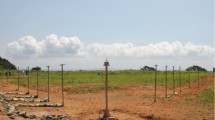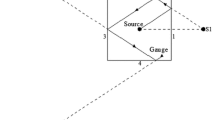Abstract
A simplified method is proposed for analyzing the overpressure history of an optional point on the walls of a closed cuboid due to its internal optional point-explosion. Firstly, the overpressure histories of all nodes on the walls of a cube with a side-length of 2 m are computed under a reference-charge explosion at each node of its inner space using the LS-DYNA software, and then are collected to form a reference database. Next, with the thought of the isoparametric finite element, an interpolating algorithm is established to calculate the overpressure history of an optional point on the walls induced by an explosion at any position inside this cubic space. Then, some ratio factors of peak values and durations of overpressure on the walls, reflecting changes in the charge weight and side-length of a cuboid, are derived and applied subsequently, together with their contributing coefficients, to make some modifications to the above algorithm, which achieves an approximate simulation to the overpressure histories on the walls under the optional charge weight and cuboid size. Finally, example results verify the rapidity and validity of this method, and provide feasible ranges of the charge weight and cuboid size according to the current computing condition.
Similar content being viewed by others
References
Baker W E, Cox P A, Westine P S. Explosion Hazards and Evaluation (Fundamental Studies in Engineering 5)[M]. Elsevier Scientific Publishing Company, Amsterdam, the Netherlands, 1983.
Smith P D, Mays G C, Rose T A et al. Small scale model of complex geometry for blast overpressure assessment [J]. International Journal of Impact Engineering, 1992, 12(3): 345–360.
Pritchard D K, Freeman D J, Guilbert P W. Prediction of explosion pressures in confined spaces[J]. Journal of Loss Prevention in the Process Industries, 1996, 9(3): 205–215.
Lee C K B. Scaling blast-induced wall loadings in a rectangular room[J]. Pressure Vessels and Piping Division (Publication PVP), 1999, 394: 45–54.
Louca L A, Friis J, Bailey P et al. Experimental and numerical studies of a blast loaded cubic structure[C]. In: Proceedings of the 12th (2002) International Offshore and Polar Engineering Conference. Kitakyushu, Japan, 2002. 397–403.
Feldgun V R, Kochetkov A V, Karinski Y S et al. Internal blast loading in a buried lined tunnel[J]. International Journal of Impact Engineering, 2008, 35(3): 172–183.
Yang Xiumin, Yang Kezhi. Explosion effects inside a confined space[J]. Chinese Civil Air Defence, 2006, 186(8): 64–64 (in Chinese).
Rao Guoning, Hu Yiting, Chen Wanghua et al. Numerical and experimental study on internal blast in explosion chamber[J]. Journal of Ballistics, 2008, 20(1): 76–79, 84 (in Chinese).
Liu Jingbo, Yan Qiushi, Wu Jun. Analysis of blast wave propagation inside tunnel[J]. Transactions of Tianjin University, 2008, 14(5): 358–362.
Wang Zhongqi, Wu Jianguo, Bai Chunhua et al. Response of box-type structures under internal-blast loading[J]. Transactions of Tianjin University, 2006, 12(Suppl): 112–116.
Li Xiudi, Zheng Yingren. In-tunnel blast pressure empirical formulas for detonations external, internal and at the tunnel entrance[J]. Transactions of Tianjin University, 2006, 12(Suppl): 177–181.
Li Yuchun, Shi Dangyong, Zhao Yuan. Fundamental Theory and Engineering Practice for ANSYS10.0/LS-DYNA Software[M]. China Water Power Press, Beijing, 2006 (in Chinese).
Zienkiewicz O C. The Finite Element Method[M]. 4th Ed. The McGraw-Hill Companies, London; New York, 1987.
Zeng Pan. Finite Element Analysis and Applications [M]. Tsinghua University Press, Beijing, 2004 (in Chinese).
Department of the Army, Navy and the Air Force. Technical Manual (TM5-1300). To Resist the Effect of Accidental Explosions [M]. Washington DC, 1990.
Author information
Authors and Affiliations
Corresponding author
Additional information
Supported by National Natural Science Foundation of China (No. 50678116), National Key Technology R&D Program of China (No. 2006BAJ13B02), and Tianjin Municipal Major Project of Application Foundation and Frontal Technology Research (No. 08JCZDJC19500).
TIAN Li, born in 1970, male, Dr, associate Prof.
Rights and permissions
About this article
Cite this article
Tian, L., Li, Z. & Zhou, Q. Simplified computation of reflective overpressure in closed cuboid space due to internal explosion. Trans. Tianjin Univ. 16, 395–404 (2010). https://doi.org/10.1007/s12209-010-1410-6
Accepted:
Published:
Issue Date:
DOI: https://doi.org/10.1007/s12209-010-1410-6




